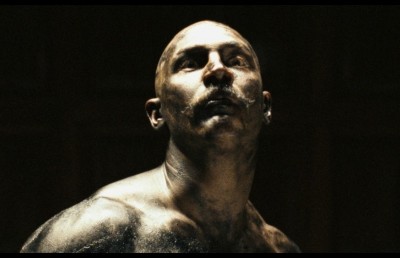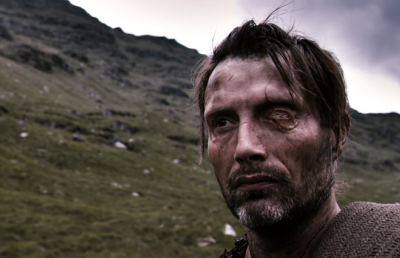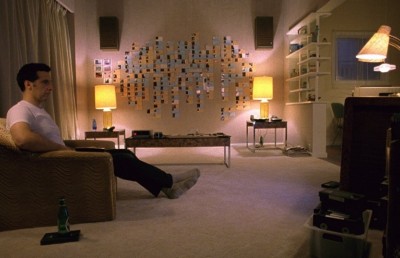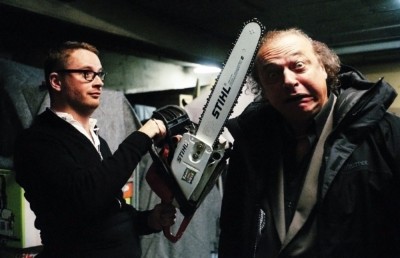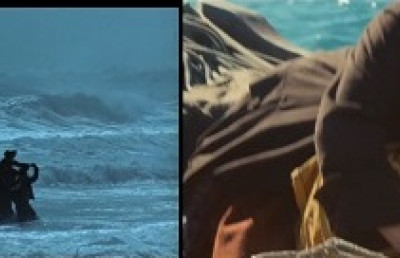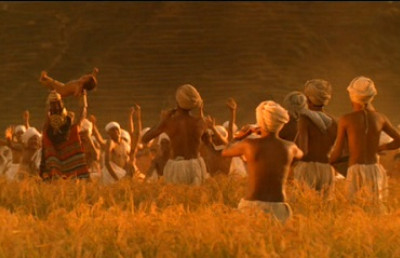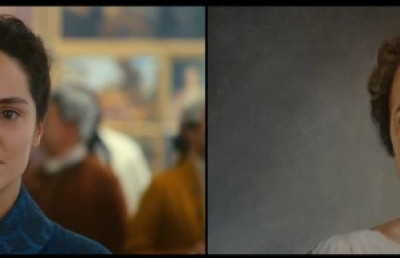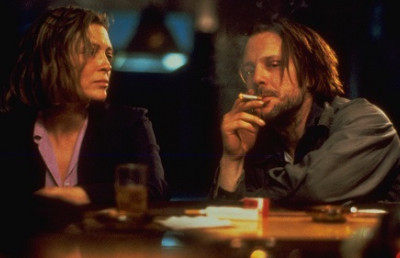The Driver Errant: A Critical Evaluation of Drive and “New” Masculinity
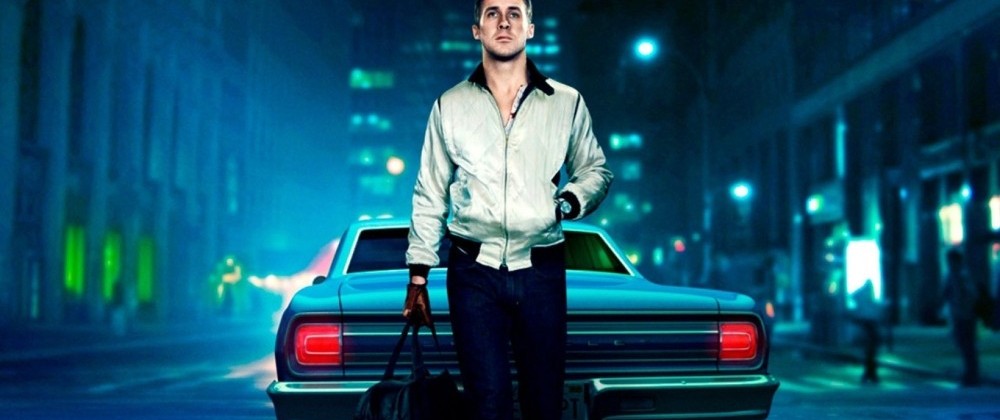
When Nicolas Winding Refn’s Drive was released to the North American public in 2011, the film had already garnered an impressive collection of rave reviews and critical acclaim. [1] Earlier that year, the film earned Refn the Best Director Award at Cannes, although this was only the most distinguished amongst the many accolades and nominations that Drive received from critics and festivals. Praise for Drive has centred primarily on its combination of genres, specifically, it’s mixing of noir, romance, crime/thriller, and action film elements. Many have even taken to hailing the film as an art film, taking care to note Refn’s preference for long takes, still camera framing, and judicious graphic compositions throughout the film, along with its euro-pop soundtrack. There is nothing new, in this sort of unreserved praise for films which combine or ‘transcend’ genre. Indeed, it would be an extremely daunting task to locate the first film to do so within the more-or-less agreed upon canon of ‘great’ cinema: was it Buster Keaton’s The General, Jean-Luc Godard’s Breathless, or Quentin Tarantino’s Pulp Fiction? Indeed, the praising of such films has become so prominent a trend that it is perhaps high time to re-evaluate whether or not genre-mixing alone constitutes sufficient reason to celebrate a film as noteworthy or exceptional.
This question becomes particularly pertinent in the case of Drive , where the apparent stylistic plurality distracts from the film’s uncritical dissemination of all-but-defunct gender stereotypes. Beneath the apparently innovative genre-bending aesthetic choices that constitute Drive ’s much admired “look,” is a far less innovative and dangerously naïve adoption of the medieval chivalric romance, a genre into which Refn breathes new life by updating the setting and format for contemporary audiences. Drawing inspiration from Noel Carroll’s argument for the reintroduction of the moral criterion in the evaluation of art, this essay will examine the way in which Drive reconstructs an outmoded model of chivalric masculinity, questioning whether or not critical praise for the film is, in this case, appropriate. Indeed, I propose that these very aesthetic choices, so praised for their innovations, often function only to enhance the appeal of this model, thereby rendering more palatable a film which irresponsibly promotes an outdated paradigm of masculinity and gender relations.
The validity of moral criteria in aesthetic judgement is taken up by Noel Carroll in his 1985 essay “Formalism and Critical Evaluation.” Carroll argues that although morality cannot be the sole basis of aesthetic merit, there is no reason to ignore the moral element in a work which is made better by its “moral excellence,” [2] the humanist works of Akira Kurosawa for example. Carroll argues against the inverse, although he does admit that there are occasions when “in assessing the value of the formal arrangements as reinforcing the theme, it seems natural to ask if the theme was worth reinforcing.” [3] This question is especially relevant today, in a world where media-saturation and fabricated images have become such a prominent component of everyday life. In assessing any image, especially those found at the centre of enthusiastic reception, it is worth remembering cultural theorist Jean Baudrillard’s observation that “the representation of politics has been replaced by the politics of representation.” [4] Thus, through this critique of Refn’s film, I hope to demonstrate how Drive ’s uncritical take on chivalric romance, combined with his seductively flashy aesthetic, serves to undermine a progressive discourse of gender roles in cinema, reinforcing outdated stereotypes.
Any inquiry into the politics of representation at work in Refn’s film begs the question what does Drive say about the world we live in? Although it is tempting to view Drive as an “exercise in style,” [5] even when examining its formal elements it is hard to ignore that the film’s stylistic plurality merely serves to reinvigorate an outdated model of masculinity with new life by keeping the audience distracted while a traditional narrative plays out. Though it is true that Drive combines noir lighting, a synth-pop soundtrack, graphic violence, and the static compositions of slow cinema, these elements can all be viewed as functioning in support of the film’s true genre, the chivalric romance, the problematic implications of which Refn does not once deign to address.
The narrative form of the film sticks firmly to that of the standard chivalric romance, a heroic prose and verse narrative originating from aristocratic literature of High Medieval and Early Modern Europe. Although he has been compared to Clint Eastwood’s Man with No Name, [6] the Driver is perhaps most closely related to the wandering knight errant of high medieval poetry. After years of desolate roaming, he meets a lady (Irene) who at last gives meaning to his life. Like Guinevere and many other ladies of Arthurian legend, she is characteristically married, and their love remains chaste although clearly motivated by a mutual sexual attraction. Henceforth, the knight errant Drives only in honour of his lady. He also must defend her, via the defense of her husband, just as Sir Lancelot defends King Arthur in the name of his Queen. When her husband dies, the knight must defeat the villains in order to protect his lady, after which he disappears into the distance.
Although Drive updates the story’s setting, it does little to engage with the aspects of the chivalric model which have become problematic in light of twentieth century movements towards gender equality. The film’s protagonists function as little more than archetypes of an idealized femininity and masculinity put forward by medieval romances. In the character of Irene, we see the very image of the damsel in distress, without any agency of her own. Throughout the film she remains completely passive, not only unable to change her destiny, but denied even the opportunity to try by a filmmaker focused on imagery and aesthetics. Significantly, the men of the film never bother to ask, inform, or discuss their courses of action with Irene, although her life and that of her son hang in the balance. Kept uninformed in the sheltered sphere of her high-rise apartment, events happen to Irene without her knowledge or consent – she never makes them happen herself. This is true even of the climactic kiss bestowed upon her by the nameless Driver.
If Irene’s key characteristic is passivity, the Driver’s main imperative is action. The audience is introduced to the Driver already in mid heist, helping two criminals escape from a robbery. We are left questioning his motivations however, because as a man of action, the Driver needs not explain himself. Subsequently, the film never bothers to supplement this single essential attribute except via the soundtrack, which asks the viewer to simply trust that “there’s something about [him] that’s hard to explain.” Although upon meeting Irene he gains a second attribute, selflessness, the Driver’s self-sacrificing resolve to save his lady only further cements his position as the latest in a long line of heroic male protagonists whom the audience is expected to idealize, stretching from the Knights errant on.
The film’s costume design functions to reinforce these archetypal identifications in its principle protagonists. Irene, as the unattainable object of the Driver’s affection, is most characteristically dressed in long skirts which evoke the medieval lady and passive femininity. The Driver, on the other hand, is characteristically clad in his now-iconic silver scorpion jacket, a modern version of shining armour. The car replaces the steed, naturally, and this substitution completes the transformation of the knight of yore into the modern day Driver. Significantly, Driver is the only name the character is given [why is this significant?]. The minimal dialogue further ensures that the characters are never able to move beyond their archetypal origins, or engage with the stereotypes they represent.
With little by way of dialogue, the story of the film is conveyed visually, essentially remaking both the male and female protagonists into silent objects presented to the viewer. The much-praised static compositions that characterize the majority of the film contribute to this objectification, presenting the actors as statuesque props that convey little except passivity. A case in point is seen in the strip club scene, where strippers sit stock-still while the Driver attacks their boss. The camera pans and tracks slowly across their nude bodies as the Driver calls Nino, transforming them into mere props in the décor of the mise-en-scene.
Usually however, the objectifying eye of the camera is primarily focused on the film’s male protagonist. The credit sequence offers a salient example of this objectification, and sets the tone for the rest of the film. After the initial chase scene serving as exposition, a cut is made to the nocturnal Los Angeles skyline. Non-diegetic music begins, and the skyline fades onto a medium close up of the Driver in his car. The camera occupies the passenger seat, its de facto position for the car scenes of the film, and looks up at the Driver from below, encouraging the viewer to idealize this hero in a position of power. The Driver stares off-screen, his face half obscured in the shadows, and the shot is held for a full ten seconds before he turns his face forward and hits the ignition. The film is riddled with static, silent shots like these, which offer the cast as objects for aesthetic appreciation, upon which the viewer can project his/her own fantasies.
??Drive??’s soundtrack has been particularly praised for making accessible the apparently mysterious subjective state of its main character. The score is often synchronized with the Driver’s actions and expressions, for example, when the Driver takes Irene and her son to the ravine, the song “A Real Hero” is queued in tandem with the Driver’s smile and ends only when the three are back in Irene’s apartment. The songs chosen, however, are so literal that it is difficult to regard them as subjective. On the contrary, the soundtrack serves as a commentary reinforcing the theme of chivalric masculinity that permeates the film, negating any trace of ambiguity in the characters’ motives.
This song (“A Real Hero”) is featured twice in the film, first when the Driver takes Irene and her son to the ravine and for a second time after the Driver kills the last of the villains, driving into the distance. The song’s lyrical content is straightforward, and cements the one-dimensional image of the Driver that is suggested by the lack of dialogue, objectifying composition, and straightforward adoption of the chivalric romance narrative structure. He is a “real human being and a real hero,” the song states, literally providing the viewer with the director’s interpretation of the film as a fairy tale about a man who is a “real human being by day and real hero by night.” [7] Ultimately, rather than lending subjective insight into the character, the soundtrack only objectifies the Driver as a model of masculinity more intensely.
Although Refn admittedly does an admirable job of turning Los Angeles into a fairy tale world with his static, symmetrical compositions and slow tracking movements (especially the overhead views of the LA highways shot from a helicopter, which transform the city into a stylized maze of lines and shadows in the credit sequence), his film never critically engages with the many genre tropes and motifs that he adopts, simply presenting them wholesale. Refn’s failure to do so indicates either a lack of concern or ignorance of precisely what is problematic in his models, and this ignorance should not be praised simply because a number of genres have been thrown together as a post-modern combination. This is particularly troubling in the film’s depiction of gender, where the lead protagonists are defined only by their stereotypical masculinity (strength) and femininity (vulnerability). In today’s late capitalist world such representations are for many the basis of identity creation, and by representing medieval gender stereotypes in contemporary trappings, Drive irresponsibly reinforces an out-dated model which (fortunately) has already been challenged by filmmakers and academics alike.
Although a moral criterion is distinctly problematic in the evaluation of the any art object or text, it is nonetheless an important factor in the analysis of representation. Every film carries within it certain ideological biases, and it is important to always be aware of these biases when viewing the film. Appreciation is still possible, but praise must be tempered with critical examination of the way the film chooses to represent its subjects. In the case of Drive , where narrative, costuming, framing, and soundtrack come together to create an icon of masculinity, the ideological implications of the film are intimately bound up in its aesthetic. When analysing and assessing a film, it is important to consider not only the aesthetic choices themselves, their wider impact. Looking behind the polished surface of Drive it is clear that these choices function to imbue the audience with a sense of admiration for the image of the male protagonist, promoting an outmoded stereotype of gender that all responsible filmmakers, critics, and audience members should try to combat.
Endnotes
1 “Critic Reviews for Drive.” Metacritic. N.p., n.d. Web. 10 Nov. 2012.
2 Noel Carroll, “Formalism and Critical Evaluation,” The Reasons of Art, ed. Peter McCormick (University of Ottawa Press, 1987): 329.
3 Carroll, 334.
4 Anne Friedberg, “The End of Modernity: Where is Your Rupture?” Window Shopping: Cinema and the Postmodern (Berkeley: University of California Press, 1993), 179
5 Ebert, Roger. “Drive.” Rogerebert.com/The Chicago Sun-Times. September 14, 2011.
6 Pink, Dominic. “[Review] DRIVE is the Best Film of 2011.” A Fistful of Culture. N.p., 9 Nov. 2011. Web. 10 Nov. 2012.
7 Dennis Lim, “Cannes Q&A: Driving in a Noir LA,” The New York Times, May 22, 2011.
Bibliography
Carroll, Noel. “Formalism and Critical Evaluation.” In The Reasons of Art, edited by Peter McCormick, 327-335. University of Ottawa Press, 1987.
Ebert, Roger. “Drive.” Rogerebert.com/The Chicago Sun-Times. September 14, 2011.
Friedberg, Anne. “The End of Modernity: Where is Your Rupture?” In Window Shopping: Cinema and the Postmodern, 157-179. Berkeley: University of California Press, 1993.
Lim, Dennis. “Cannes Q&A: Driving in a Noir LA.” The New York Times. May 22, 2011.
Pink, Dominic. “[Review] DRIVE is the Best Film of 2011.” A Fistful of Culture. N.p., 9 Nov. 2011. Web. 10 Nov. 2012.
“Critic Reviews for Drive.” Metacritic. N.p., n.d. Web. 10 Nov. 2012.


